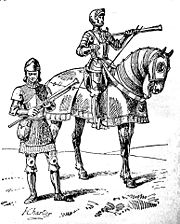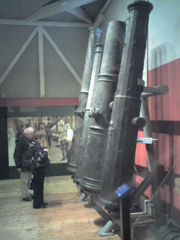
Culverin
Encyclopedia

Musket
A musket is a muzzle-loaded, smooth bore long gun, fired from the shoulder. Muskets were designed for use by infantry. A soldier armed with a musket had the designation musketman or musketeer....
, and later a medieval cannon
Cannon
A cannon is any piece of artillery that uses gunpowder or other usually explosive-based propellents to launch a projectile. Cannon vary in caliber, range, mobility, rate of fire, angle of fire, and firepower; different forms of cannon combine and balance these attributes in varying degrees,...
, adapted for use by the French
France
The French Republic , The French Republic , The French Republic , (commonly known as France , is a unitary semi-presidential republic in Western Europe with several overseas territories and islands located on other continents and in the Indian, Pacific, and Atlantic oceans. Metropolitan France...
in the 15th century, and later adapted for naval use by the English
England
England is a country that is part of the United Kingdom. It shares land borders with Scotland to the north and Wales to the west; the Irish Sea is to the north west, the Celtic Sea to the south west, with the North Sea to the east and the English Channel to the south separating it from continental...
in the late 16th century. The culverin was used to bombard targets from a distance. The weapon had a relatively long barrel and a light construction. The culverin fired solid round shot
Round shot
Round shot is a solid projectile without explosive charge, fired from a cannon. As the name implies, round shot is spherical; its diameter is slightly less than the bore of the gun it is fired from.Round shot was made in early times from dressed stone, but by the 17th century, from iron...
projectiles with a high muzzle velocity, producing a relatively long range and flat trajectory. Round shot refers to the classic solid spherical cannonball
Round shot
Round shot is a solid projectile without explosive charge, fired from a cannon. As the name implies, round shot is spherical; its diameter is slightly less than the bore of the gun it is fired from.Round shot was made in early times from dressed stone, but by the 17th century, from iron...
.
Hand culverins



The hand culverin consisted in a simple smoothbore
Smoothbore
A smoothbore weapon is one which has a barrel without rifling. Smoothbores range from handheld firearms to powerful tank guns and large artillery mortars.-History of firearms and rifling:...
tube, closed at one end except for a small hole designed to allow ignition of the gunpowder
Gunpowder
Gunpowder, also known since in the late 19th century as black powder, was the first chemical explosive and the only one known until the mid 1800s. It is a mixture of sulfur, charcoal, and potassium nitrate - with the sulfur and charcoal acting as fuels, while the saltpeter works as an oxidizer...
. The tube was held in place by a wooden piece which could be held under the arm. The tube was loaded with gunpowder and lead bullets. The culverin was fired by inserting burning slow match
Slow match
Slow match or match cord is the very slow burning cord or twine fuse used by early gunpowder musketeers, artillerymen, and soldiers to ignite matchlock muskets, cannons, and petards...
into the hole.

Field culverins
There were three types of culverin in use, distinguished by their size: the culverin extraordinary, the ordinary, and the least-sized.| Name | Bore diameter | Length | Weight | Shot diameter | Shot weight |
|---|---|---|---|---|---|
| culverin extraordinary Demi-cannon The demi-cannon was a medium sized cannon, similar to but slightly larger than a culverin and smaller than a regular 42lb cannon developed in the early 17th century. A full cannon fired a 42-pound shot but these were discontinued in the 18th century as they were seen as too unwieldy. The lower... |
5½ inches (140 mm) | 32 calibers (14 ft 8 in; 4.5 m) | 4800 pounds (2200 kg) | 5¼ inches (135 mm) | 20 pounds (9.1 kg) |
| ordinary culverin | 5½ inches (140 mm) | 25 calibers (12 ft; 3.6 m) | 4500 pounds (2000 kg) | 5½ inches (140 mm) | 17 pounds (7.71107 kg) |
| culverin of the least size | 5 inches (127 mm) | 29 calibers (12 ft; 3.6 m) | 4000 pounds (1800 kg) | 3¼ inches | 14 pounds (6.35029318 kg) |

Demi-culverin
The demi-culverin was a medium cannon similar to but slightly larger than a saker and smaller than a regular culverin developed in the early 17th century. Barrels of demi-culverins were typically about long, had a calibre of and could weigh up to . It required of black powder to fire an round...
or culverin-moyen (4½ inches (114 mm), 10 pound (4.5 kg) shot.
Overall, the culverin was a significant advance over the ballista
Ballista
The ballista , plural ballistae, was an ancient missile weapon which launched a large projectile at a distant target....
, which was the "light artillery" unit of the previous eras. Since it fired a ball of iron and relied on gunpowder for propulsion, the heavier ball meant a more stable flight and the gunpowder propulsion meant a faster and farther-ranged weapon. A replica culverin extraordinary has achieved a muzzle velocity of 408 m/s, and a range over 450 m using only minimal elevation. This velocity and mass imply that the cannonball had a kinetic energy
Kinetic energy
The kinetic energy of an object is the energy which it possesses due to its motion.It is defined as the work needed to accelerate a body of a given mass from rest to its stated velocity. Having gained this energy during its acceleration, the body maintains this kinetic energy unless its speed changes...
of roughly 600 kilojoule when leaving the muzzle.
The culverin was later replaced by the field gun
Field gun
A field gun is an artillery piece. Originally the term referred to smaller guns that could accompany a field army on the march and when in combat could be moved about the battlefield in response to changing circumstances, as to opposed guns installed in a fort, or to siege cannon or mortars which...
once technology had advanced to the point where cannonballs had become explosive.
- "Hurrah! the foes are moving. Hark to the mingled din,
- Of fife, and steed, and trump, and drum, and roaring culverin."
- MacaulayThomas Babington Macaulay, 1st Baron MacaulayThomas Babington Macaulay, 1st Baron Macaulay PC was a British poet, historian and Whig politician. He wrote extensively as an essayist and reviewer, and on British history...
, Ivry, 31-32
- Macaulay
- "In this, my countrymen, be rul'd by me:
- Have special care that no man sally forth
- Till you shall hear a culverin discharg'd
- By him that bears the linstock, kindled thus;
- Then issue out and come to rescue me,
- For haply I shall be in distress,
- Or you releasèd of this servitude."
- MarloweChristopher MarloweChristopher Marlowe was an English dramatist, poet and translator of the Elizabethan era. As the foremost Elizabethan tragedian, next to William Shakespeare, he is known for his blank verse, his overreaching protagonists, and his mysterious death.A warrant was issued for Marlowe's arrest on 18 May...
, The Jew of MaltaThe Jew of MaltaThe Jew of Malta is a play by Christopher Marlowe, probably written in 1589 or 1590. Its plot is an original story of religious conflict, intrigue, and revenge, set against a backdrop of the struggle for supremacy between Spain and the Ottoman Empire in the Mediterranean that takes place on the...
, Act V
- Marlowe

